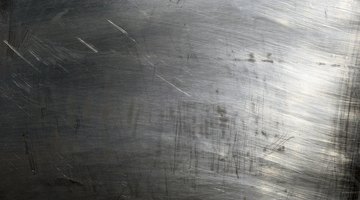DIY Zinc Countertop
Table of Contents
For a kitchen or bathroom with a sleek industrial style or a vintage country look, cover your countertops in zinc. It looks similar to stainless steel but over time develops a charming patina that resembles pewter. Zinc comes in thin sheets in a variety of thicknesses, though 0.027-inch-thick to 0.

060-inch-thick sheets work best for covering countertops. Requiring just a few simple tools, a zinc countertop is easy for the average homeowner to install.
Preparing the Zinc
Measure the length, width and thickness of the plywood countertop underlayment, and the location and dimensions of the sink. Add the thickness of the countertop and an extra 3/4 inch or more to the length and width of the countertop for any edge that will fold over the front or sides of the countertop. The extra 3/4 inch allows you to fold the zinc sheet over the bottom of the countertop, preventing cutting of hands on the sharp edges. Mark the dimensions on a zinc sheet and cut the zinc using tin snips or a metal break. Cut out the location of the sink using tin snips and a drill to create a hole where you can insert the tin snips to begin cutting into the interior of the metal where the sink and other fixtures will fit.
Attaching the Zinc
Secure the zinc sheet to the top of the countertop’s plywood underlayment using a layer of heavy-duty construction adhesive. Lay down a sheet of plywood or cardboard on top of the zinc and weigh it down with heavy boxes, books or weights. Clamp the zinc sheet down near the edges of the table using strips of wood to protect the zinc from scratches and dents. Allow the adhesive to dry overnight or according to the adhesive manufacturer’s instructions.
Bending the Edges
Mark and cut out a square at each corner of the countertop -- from the zinc’s outermost point to the corner of the plywood underlayment -- using tin snips. Fold the edges of the zinc sheet over and under the front face of the countertop by gently bending the sheet with a short length of lumber and a mallet or hammer. Tap lightly with the mallet or hammer to get the zinc to lie as close as possible to the countertop surface and to create a smooth, straight crease. Glue the zinc to the front of the countertop edge using heavy-duty construction adhesive. Tack the sheet into the bottom of the countertop using small nails.
Soldering the Corners
Create seamless corners in the zinc-covered countertop using a coil of lead-free zinc solder. Apply soldering flux to the corners first to help the solder stick to the metal. Heat a soldering iron and use it to melt the zinc solder into the open seams at the corners. Let the solder harden, then even out the corners using a metal file or grinder. For a smooth, shiny surface, sand the corners down with 100-grit sandpaper.
Considerations
To bend zinc sheets more easily and to prevent cracking, warm the metal to at least 70 degrees Fahrenheit using a small torch or heat gun and then bend the sheet slowly. For a seamless zinc backsplash, add a few inches to the dimensions to allow for the zinc sheet to fold up at the back to form the backsplash. When installing faucets, you can simply drill through the zinc and plywood underlayment.
The Drip Cap
- For a kitchen or bathroom with a sleek industrial style or a vintage country look, cover your countertops in zinc.
- Zinc comes in thin sheets in a variety of thicknesses, though 0.027-inch-thick to 0.060-inch-thick sheets work best for covering countertops.
- Requiring just a few simple tools, a zinc countertop is easy for the average homeowner to install.
- Secure the zinc sheet to the top of the countertop’s plywood underlayment using a layer of heavy-duty construction adhesive.
- Heat a soldering iron and use it to melt the zinc solder into the open seams at the corners.
- For a smooth, shiny surface, sand the corners down with 100-grit sandpaper.
References
Resources
Writer Bio
Ann Salter began writing professionally in 2010 and has worked extensively in the fields of art, architecture and design since 2004. Her work has appeared in informative guides on student housing cooperatives and sustainable building alternatives. Other areas of specialty include technology, health, gardening and cooking. Salter holds a Bachelor of Architectural Studies from the University of Waterloo.
Photo Credits
- isaravut/iStock/Getty Images
- isaravut/iStock/Getty Images
More Articles



